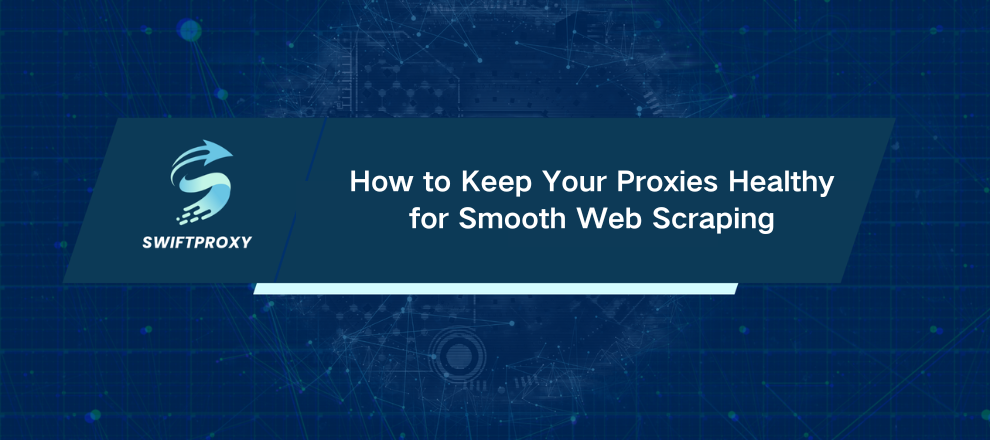How to Keep Your Proxies Healthy for Smooth Web Scraping

Proxies are the backbone of scraping—but if you don't treat them right, they’ll get blocked fast. And once the blocks start piling up, your data pipeline slows to a crawl. Worse, your proxy pool dries out, leaving you stuck.
But don't worry. Small adjustments can save your proxies and supercharge your scraping game. We're talking practical moves that take minutes but pay off big time.
Here's how to keep your proxies alive and kicking.
1. Rotate User Agents Like a Pro
You can throw a fresh IP at every request, but if your user agent never changes, you're waving a giant red flag. The user agent reveals your device and browser info. When the same one pops up across different IPs, sites catch on instantly.
Even worse? Scrapers often send no user agent at all. That screams "bot." Real browsers always send this data. Use a user agent library and feed your scraper a steady stream of realistic headers. It's an easy fix that pays huge dividends.
2. Match Proxies to Location
IP addresses tell a site exactly where your traffic comes from. If a German online shop suddenly sees visitors from the US, it looks fishy. That IP's blocked — no questions asked.
Some countries are on watchlists by default, especially Russia, China, and parts of the Middle East, for many Western sites. Use proxies from the same region as your target site. This keeps you under the radar.
3. Respect Robots.txt and Terms of Use
Every website has rules about what bots can and cannot do, spelled out in robots.txt files and terms of service. Ignoring those rules? You're asking for blocks — or worse, legal trouble.
Read these rules carefully. Scraping restricted pages might seem tempting, but it's a fast track to getting banned. Plus, it's just good digital citizenship to play by the site's guidelines.
4. Use Native Referrer Headers
Referrers show a site where a visitor came from. Blank or fake referrers stick out like a sore thumb. If your request says it's coming from nowhere—or from an unrelated site—servers get suspicious.
Match your referrer to the site you're scraping. Scraping eBay? Your requests should come from eBay itself. It's a subtle detail, but it makes your traffic look authentic.
5. Slow Down and Limit Requests
Blasting out hundreds of requests per second? You're asking to be flagged. Servers protect themselves from DDoS attacks, and your scraper looks like an attacker if it's too aggressive.
Instead, implement rate limiting. Two-second delays between requests can save you a lot of headaches. Fast scraping is great, but smart scraping lasts longer.
6. Break Your Patterns
Bots are predictable. That's their weakness. If your scraper acts like a machine—always the same clicks, scrolls, and timing—sites catch on.
Mix it up. Add random pauses, mimic mouse movement, scroll unpredictably. Small touches like these make your scraper behave more like a human. And humans don't get blocked.
7. Avoid Risky Search Operators
Google's search operators are powerful but can backfire. Operators like intitle: and inurl: raise red flags because they're often used for content scraping.
If you need them, double down on other protections—more IPs, longer delays, varied user agents. But if you can skip them, do. It lowers your risk of CAPTCHA traps and blocks.
8. Rotate Proxies Religiously
Using the same IP repeatedly? That's a shortcut to getting banned. Rotate your proxies with every request to stay anonymous.
You need a big IP pool for this. Swiftproxy offers enough residential IPs, so you never run short. Keep your scraper's footprint light and diverse.
9. Partner with Providers Who Refresh Proxies
A rotating proxy is only as good as its pool. If your provider can't supply fresh IPs when blocks happen, you're stuck.
Choose providers like Swiftproxy who constantly replenish their IP inventory. That way, when some proxies fall, new ones step up—no downtime, no disruption.
Conclusion
These aren't complicated tricks. Just straightforward, practical steps that will keep your proxy pool healthy and your scraping smooth. Put them all into action, and you'll see the difference fast. No more constant blocks, no more wasted proxies, just fast, reliable data collection.

















































